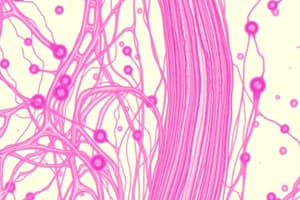Podcast
Questions and Answers
What is the fundamental unit of muscle contraction in skeletal muscle?
What is the fundamental unit of muscle contraction in skeletal muscle?
- Actin
- Myofiber
- Sarcomere (correct)
- Myosin
Which molecules interact to generate force during muscle contractions?
Which molecules interact to generate force during muscle contractions?
- Myosin and H-zone
- Actin and Myosin (correct)
- Actin and Z-disk
- Sarcomere and I-band
What surrounds the bundle of myofibers within skeletal muscle?
What surrounds the bundle of myofibers within skeletal muscle?
- Cytoplasm
- Actin filaments
- Endoplasmic reticulum
- Extracellular matrices (correct)
Which region of the sarcomere appears as a lighter-colored band?
Which region of the sarcomere appears as a lighter-colored band?
What is the role of the z-disk in skeletal muscle structure?
What is the role of the z-disk in skeletal muscle structure?
Which component enables precise control over muscle contraction and relaxation?
Which component enables precise control over muscle contraction and relaxation?
What is the key function of vascularization in skeletal muscles?
What is the key function of vascularization in skeletal muscles?
Which component is responsible for aerobic respiration in skeletal muscles?
Which component is responsible for aerobic respiration in skeletal muscles?
What role do satellite cells play in skeletal muscle?
What role do satellite cells play in skeletal muscle?
How do motor neurons contribute to skeletal muscle function?
How do motor neurons contribute to skeletal muscle function?
What is the primary purpose of glycogen storage granules in skeletal muscles?
What is the primary purpose of glycogen storage granules in skeletal muscles?
How does understanding the histology of skeletal muscle benefit researchers?
How does understanding the histology of skeletal muscle benefit researchers?
Study Notes
Understanding the Histology of Skeletal Muscle Structure
Skeletal muscle, a specialized type of striated muscle, plays a crucial role in generating contraction, force, and movement throughout the human body. Its complex cellular organization and intricate molecular interactions enable efficient energy production, cellular homeostasis, and effective muscle function. In this article, we delve into the histology of skeletal muscle, focusing on its unique structure and key components.
Cellular Organization
Skeletal muscle is composed of numerous muscle fibers, each containing several myofibrils. Myofibrils consist of the basic cellular unit called the sarcomere, which is the fundamental unit of muscle contraction. Arranged in parallel, these sarcomeres are responsible for the generation of force during muscle contractions through the interaction of actin and myosin molecules. Surrounding the bundle of myofibers are extracellular matrices (ECMs) and cytoskeletal networks that support and maintain the stability of the muscle tissue.
The arrangement of sarcomeres within myofibrils creates a repeating pattern of alternating bands, known as the I-band and A-band. Additionally, a lighter-colored band called the H-zone and an unstained region called the z-disk can be observed within the sarcomere. This organized arrangement allows for precise control over muscle contraction and relaxation.
Vascularization and Innervation
Skeletal muscles are highly vascularized, allowing for adequate blood supply and nutrient delivery. They are also innervated by motor neurons, which transmit signals for muscle contraction through the release of neurotransmitters like acetylcholine at the neuromuscular junction.
Metabolic Components
To facilitate efficient energy production, skeletal muscle contains various metabolic components, such as mitochondria for aerobic respiration and glycogen storage granules for anaerobic glycolysis. These components ensure that muscles can produce energy based on the demands placed upon them, whether in low-intensity tasks or high-intensity sprints.
Regeneration and Adaptation
In response to damage or injury, skeletal muscle has the capacity to regenerate and adapt. Satellite cells, located adjacent to muscle fibers, play a crucial role in muscle repair and growth. Furthermore, skeletal muscle can respond to stressors and modulate its gene expression profile to promote healing processes or increase muscle strength.
Understanding the histology of skeletal muscle provides valuable insight into the complex organization and functionality of the muscle tissue. By studying these structures and components, researchers can gain a deeper understanding of how muscles work and develop targeted interventions for treating muscle-related conditions or enhancing athletic performance.
Studying That Suits You
Use AI to generate personalized quizzes and flashcards to suit your learning preferences.
Description
Test your knowledge on the cellular organization, vascularization, innervation, and metabolic components of skeletal muscle. Learn about the unique structure and key components of skeletal muscle tissue.



